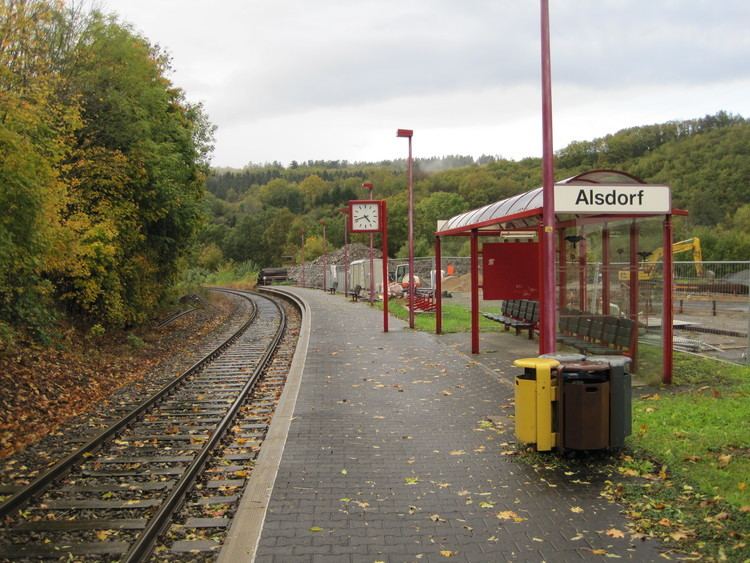Admin. region Köln Time zone CET/CEST (UTC+1/+2) Area 31.66 km² Postal code 52477 Administrative region Cologne | Postal codes 52477 Population 45,522 (31 Dec 2010) Dialling code 02404 | |
 | ||
Alsdorf ( [ˈalsdɔʁf]) is a municipality in the district of Aachen, in North Rhine-Westphalia, Germany. Until the 21st century Alsdorf was a mining area, but now many service companies have established themselves in Alsdorf. Besides, Alsdorf has an indoor arena, a cinema, a mining museum and a zoo. One of Alsdorf's famous sights is the old Castle.
Contents
- Map of 52477 Alsdorf Germany
- Geography
- Waters
- History
- Districts
- Council
- Alsdorf downtown
- Blumenrath
- Kellersberg
- Mariadorf
- Hoengen
- Economy and infrastructure
- Traffic
- Affiliations
- Sons and daughters of the town Alsdorf
- Personalities who are associated with the city Alsdorf
- References
Map of 52477 Alsdorf, Germany
Geography
Alsdorf is located near the border triangle Germany/Belgium/Netherlands in the west of Germany. Communes bordering Alsdorf are Baesweiler, Aldenhoven, Eschweiler, Würselen, Herzogenrath and Übach-Palenberg. Alsdorf belongs to the district of Aachen.
Waters
History
Today´s city of Alsdorf is a very complex mixture of very different ingredients. A part of today's city was a part of the duchy of Limburg (later united with duchy of Brabant); and one part belonged to the territory of the duchy of Jülich.
In addition, Alsdorf consists of ancient settlements whose history dates back to medieval times, as well as settlements that arose because of the long coal mining tradition in Alsdorf. The old settlements are: Alsdorf, Bettendorf, Hoengen, Ofden, Schaufenberg, Warden and Zopp.
The name Alsdorf was mentioned for the first time in a document of the Catholic Church in the year 1191. But it might be much older than 800 years. During its history, Alsdorf changed its affiliation a few times. Along with the duchy of Brabant and the duchy of Limburg, it also belonged to the duchy of Burgundy (1430) and fell to the Habsburgs in 1482. Then in 1555, it became part of the Spanish Netherlands under the Spanish Habsburgs. In 1714, it belonged again to Austrian Habsburgs until the French invasion. After that, pursuant to a judgement of the Congress of Vienna, Alsdorf belonged to Prussia.
With the reconstruction of Germany after the Second World War, Prussia was eliminated. Its western provinces are now the state of North Rhine-Westphalia, where Alsdorf belongs to.
Until the middle of the 19th century, farming was the main industry. Only Alsdorf (approximately 1,200) and Hoengen (about 1,400) had more than 1,000 inhabitants. Population in the greater area of today's Alsdorf totalled 4,000 people.
Today the population is more than ten times larger as a result of mining, which came to Alsdorf in the middle of the 19th Century. The mining industry needed many workers. First, it was possible to cover the demand with local workers but as the mine grew, the need for workers grew. To be an attractive employer, the mine company built new houses to offer its employees good working conditions. Between 1860 and 1960, a few bigger and smaller villages were founded. These villages are: Begau, Blumenrath, Broicher Siedlung, Busch, Kellersberg, Mariadorf, Neuweiler, Ofden, Ost and Zopp. In 1932, the villages Kellerberg, Ofden, Schaufenberg, and Neuweiler were incorporated and the population grew from 11,500 to 19,711.
The great tragedy on October 21, 1930, demonstrated the danger of mine work. In the Anna II Mine, 270 men and one woman were killed. It was the second largest mining accident in Germany history.
The mine Maria closed in September 1962; the last mine in Alsdorf shut down in 1992. Since this time, Alsdorf has successfully changed its image away from a coal city to a modern business location. A few business parks have been founded, where a lot of companies have located.
Districts
Alsdorf is divided in 16 districts:
Council
The situation in Alsdorf's council after the last election in 2009:
Alsdorf (downtown)
Blumenrath
Kellersberg
Mariadorf
Hoengen
Economy and infrastructure
For over a century, coal mining was the heart of Alsdorf's economy. Coal production started in 1849, when the Maria Mine opened in Hoengen. In 1853, production started in the Anna coal mine of Alsdorf. This was the reason for an increase in production and workforce, this was particularly measurable in mine Anna but not in mine Maria, which was closed by September 1962. Unfortunately, the coal crisis has not spared Alsdorf, and the last mine was closed in 1992.
Alsdorf's biggest employer is the Cinram GmbH, with about 2,000 employees in district of Schaufenberg. This company produces up to 2 million DVDs, Blu-rays and CDs daily, exported throughout Europe. The company was founded in 1975 by Warner Music and sold in 2003 to the Canadian stock corporation Cinram International. Customers are well-known record labels and media companies like Warner Music, Twentieth Century Fox and Universal Pictures.
Besides accured companies, which either used the closeness to RWTH Aachen University or which saw the favourable location near the borders to Belgium and the Netherlands as advantage.
Traffic
Alsdorf is located in the heart of Europe, within approximately 200 km of the most important economic centers of the European Union. The town lies in the center of the tri-border region of Germany / Netherlands / Belgium.
The nearest airports are Maastricht Aachen Airport, Cologne Bonn Airport and Düsseldorf Airport.
Alsdorf has a direct connection to Bundesautobahn 4 and Bundesautobahn 44; both are German freeways.
Furthermore, Alsdorf provides a very good bus system. Every part of Alsdorf or Aachen is served by the buses of ASEAG, the local bus company.
Since 2005, Alsdorf is connected to the regional train system. The railway network has extended steadily; hence you can reach Mariadorf since 2011 by regional train.
Affiliations
Alsdorf has twin-city links with:
